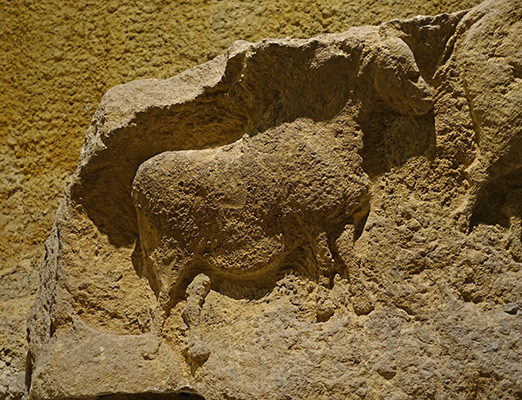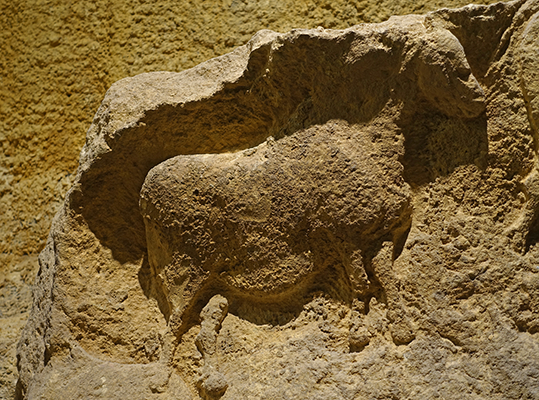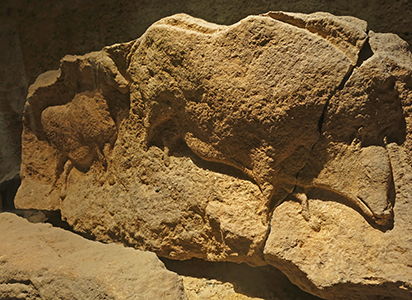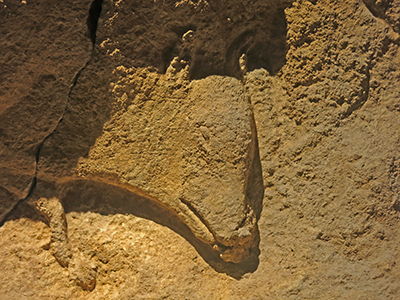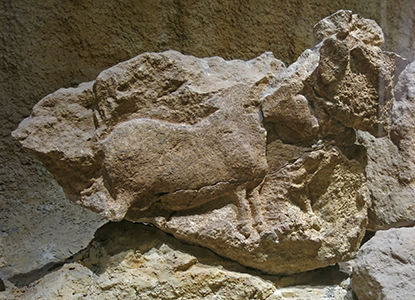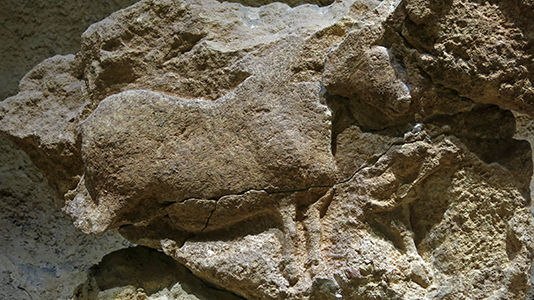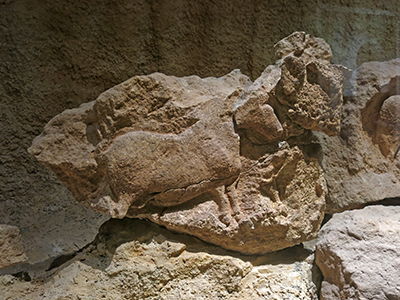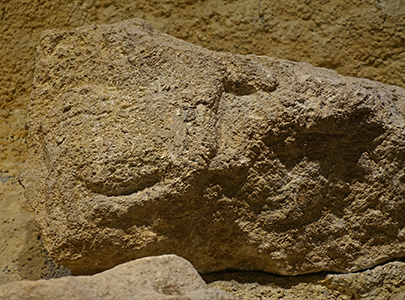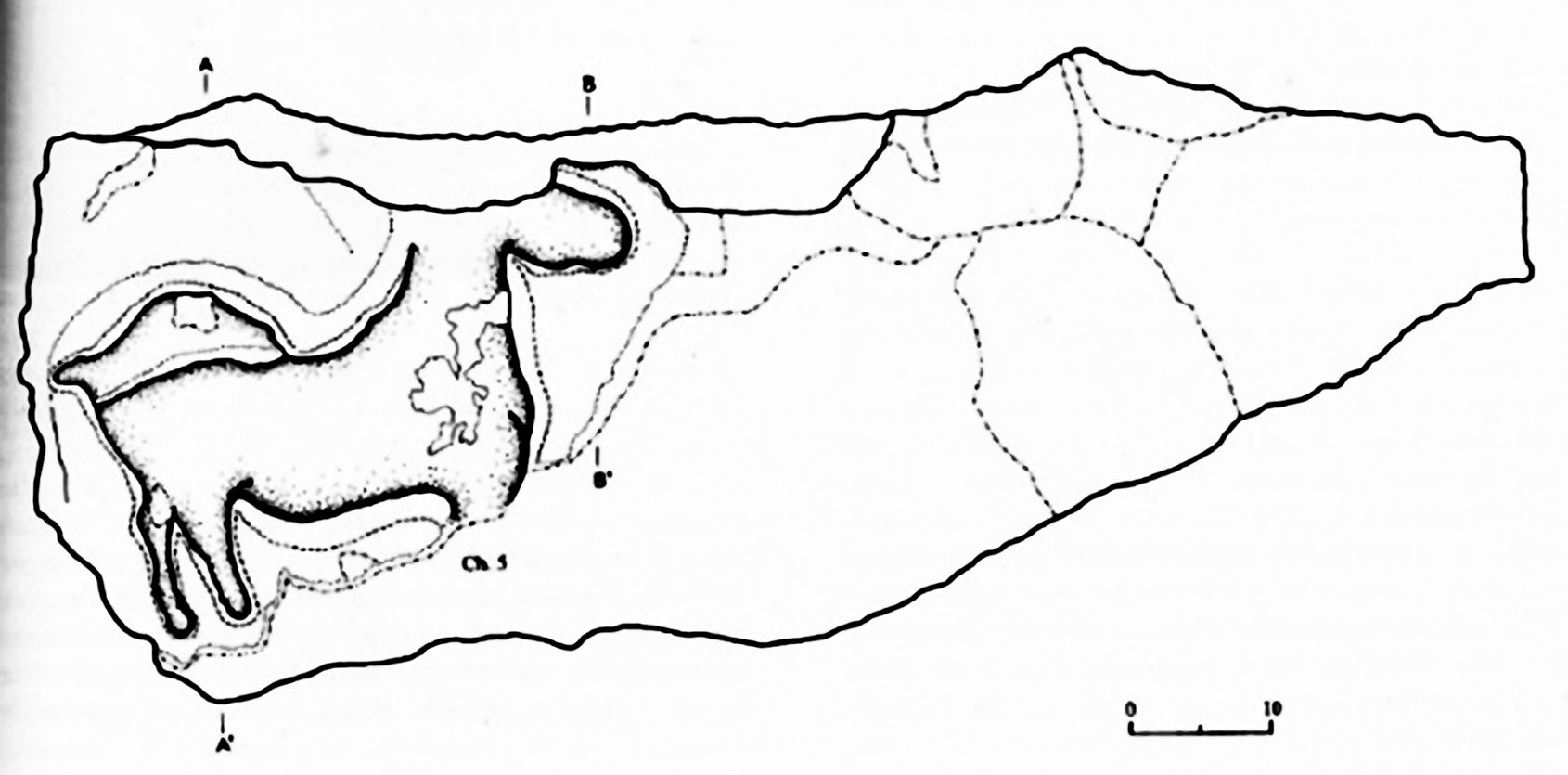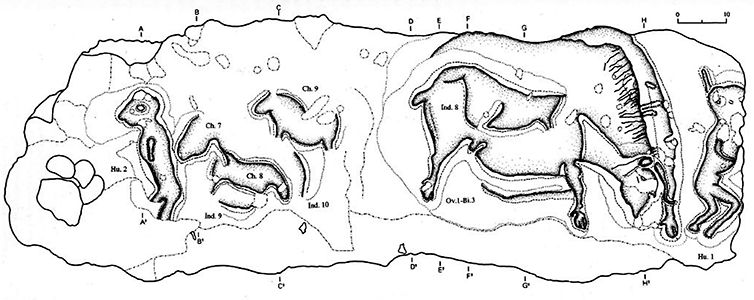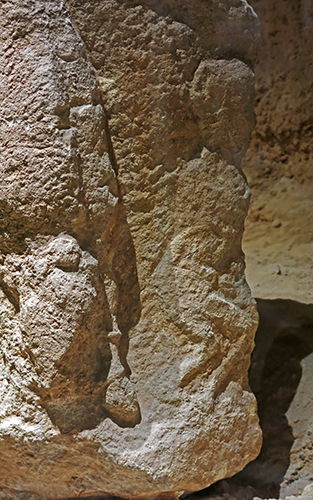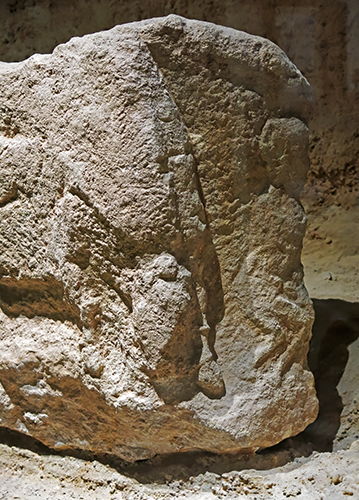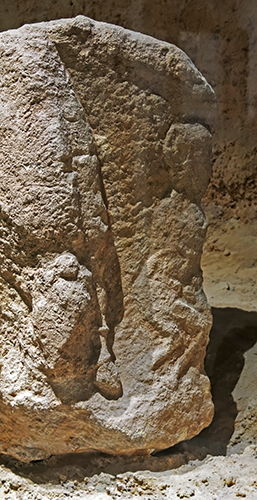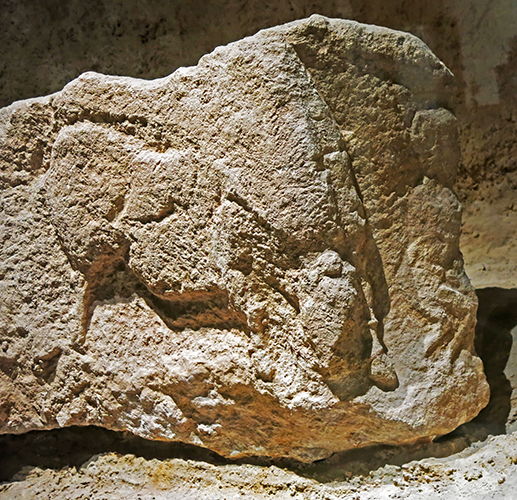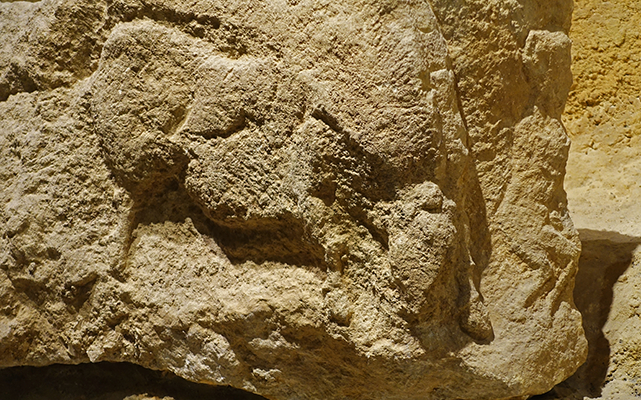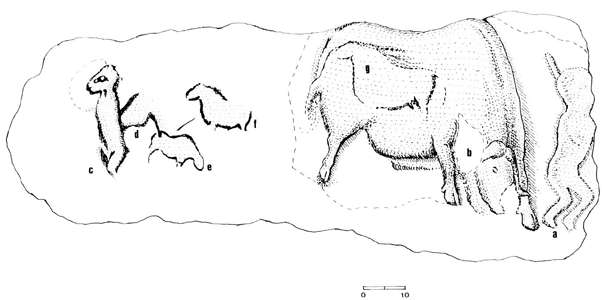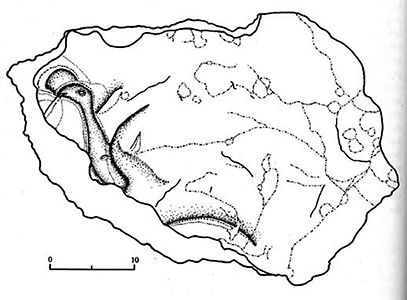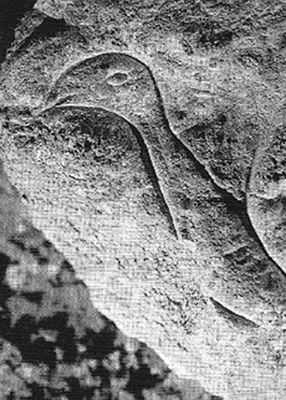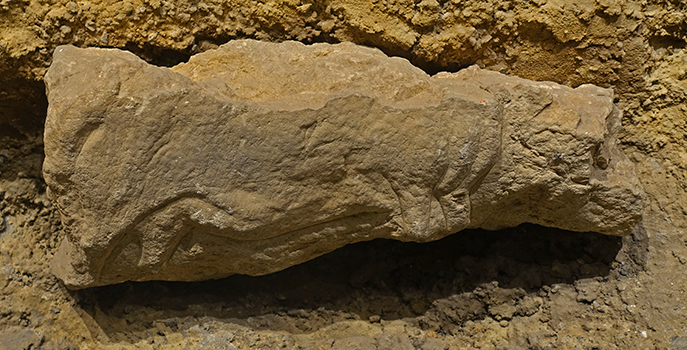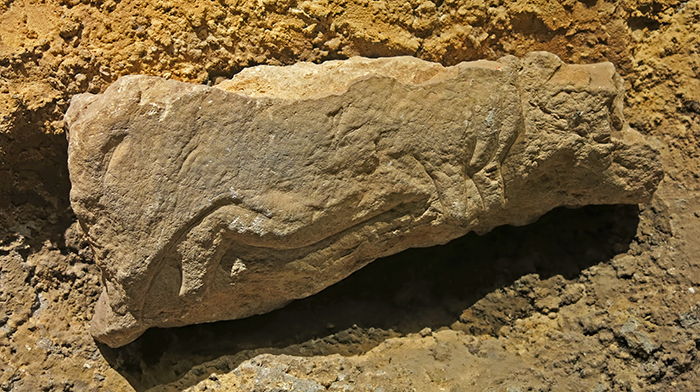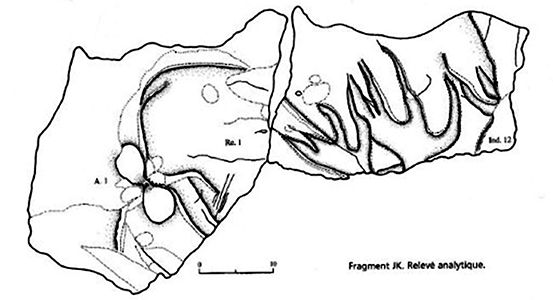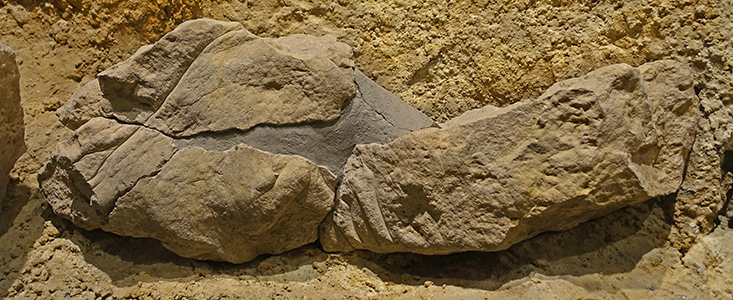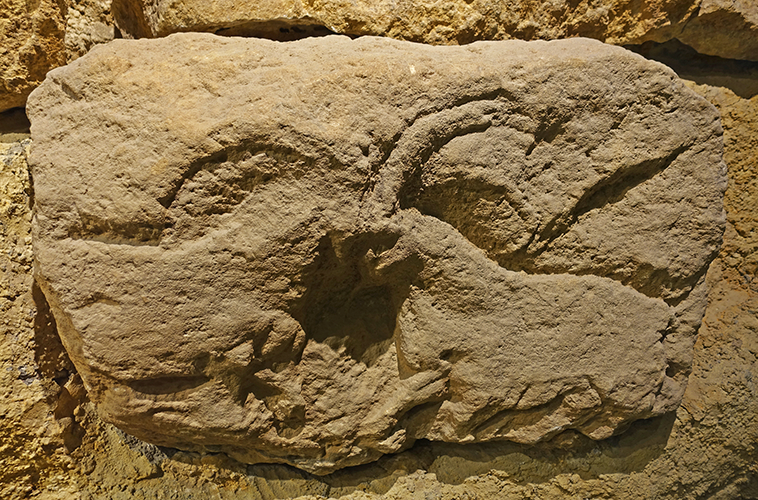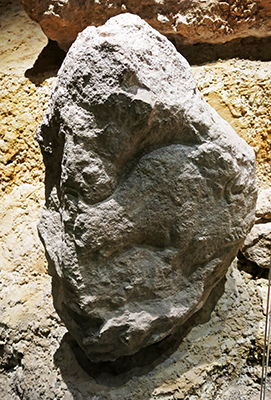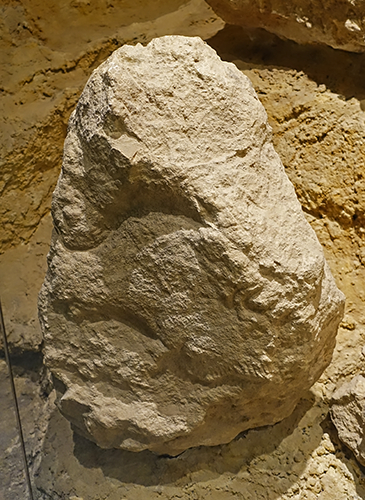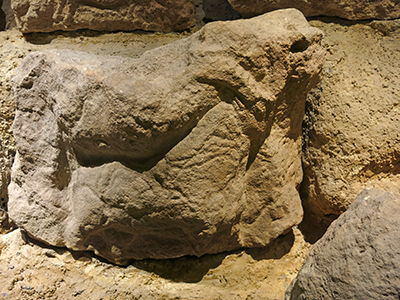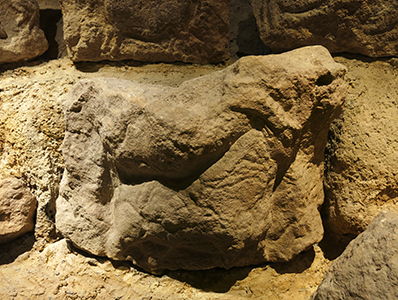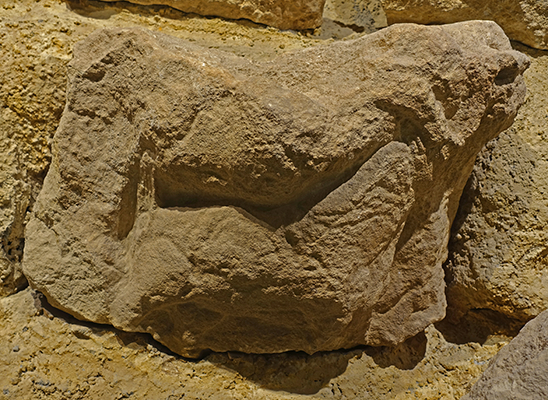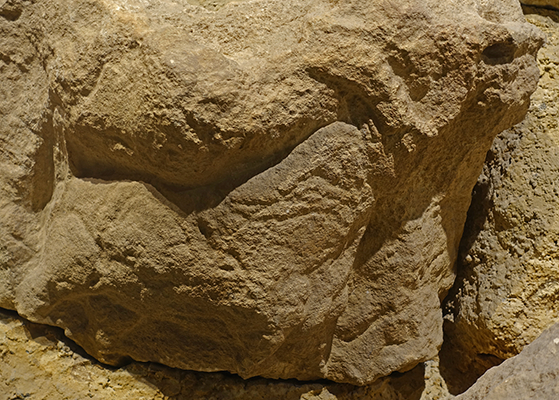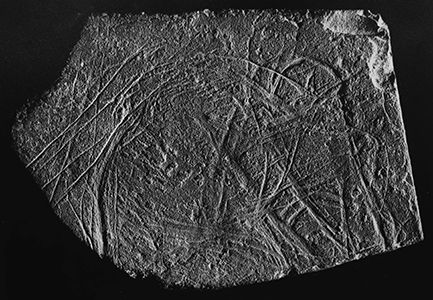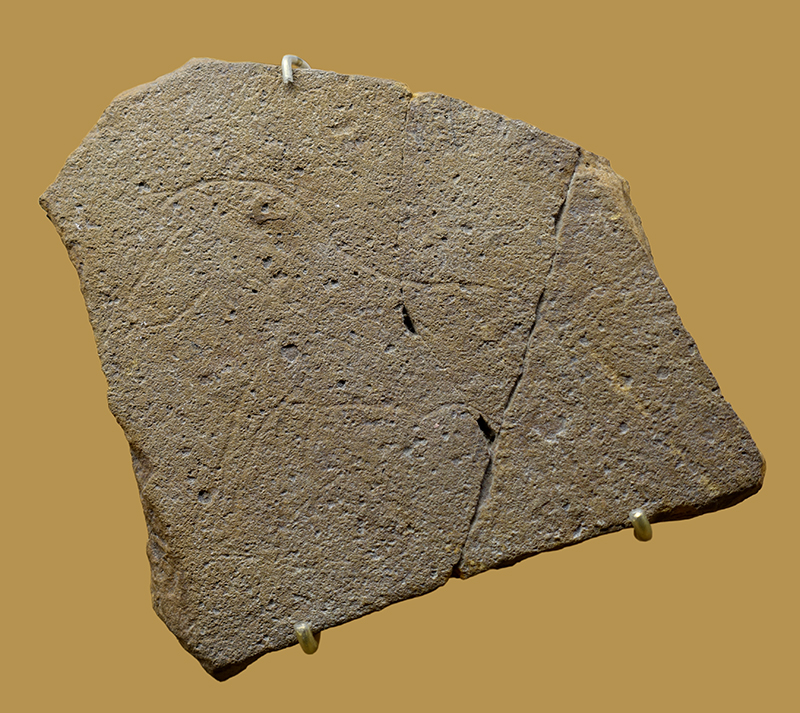Back to Don's Maps
 Back to Archaeological Sites
Back to Archaeological Sites
Roc de Sers
Located in the vallée de l'Echelle, a tributary of the Touvre, the site of Roc de Sers was excavated in 1908 by A. Favraud and by Dr. Henry Martin from 1917. The first elements of the sculpted frieze of Roc de Sers were discovered in 1927 by Dr. Henry-Martin. These excavations were interrupted in 1933. Other carved items were discovered in 1951 by R. Lantier and Mlle G. Henry-Martin.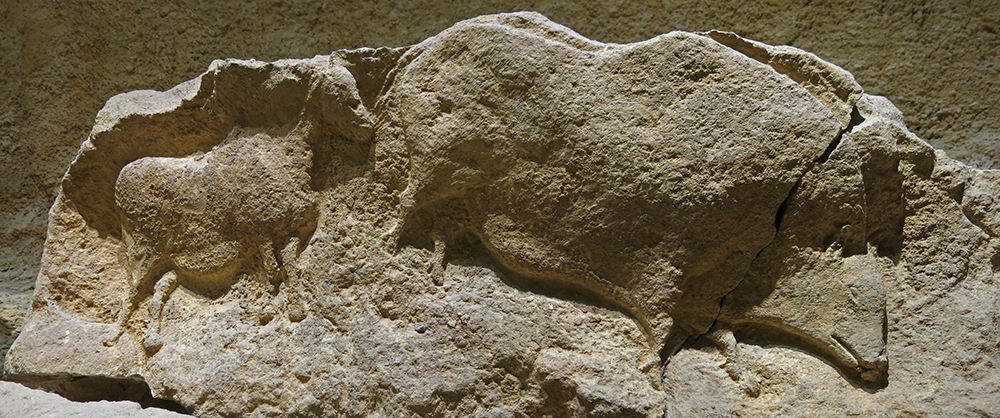
This is the most famous of all the sculptures at Roc de Sers. It depicts a horse on the left, and a bison/boar on the right, with characteristics of both species. It bears no trace of having been resculpted, making it a truly composite animal.
Photo: Don Hitchcock 2014
Source: Original, Musée d'Archeologie Nationale et Domaine, St-Germain-en-Laye
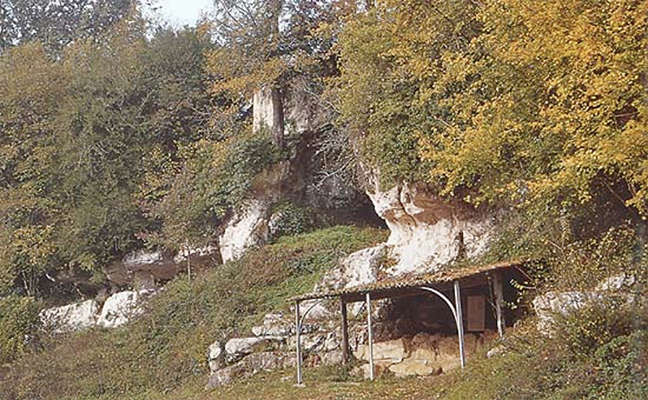
Rock shelter of Roc de Sers (Charente)
Photo: Airvaux (2001)
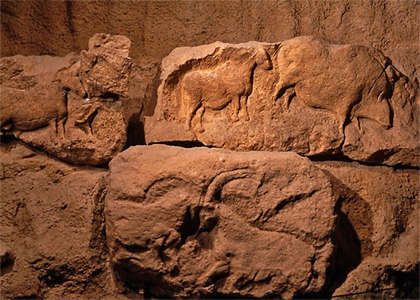
Roc de Sers
Photo: http://solutreen.over-blog.com/article-l-animal-valeur-symbolique-l-art-parietal-solutreen-du-roc-de-sers-71875818.html
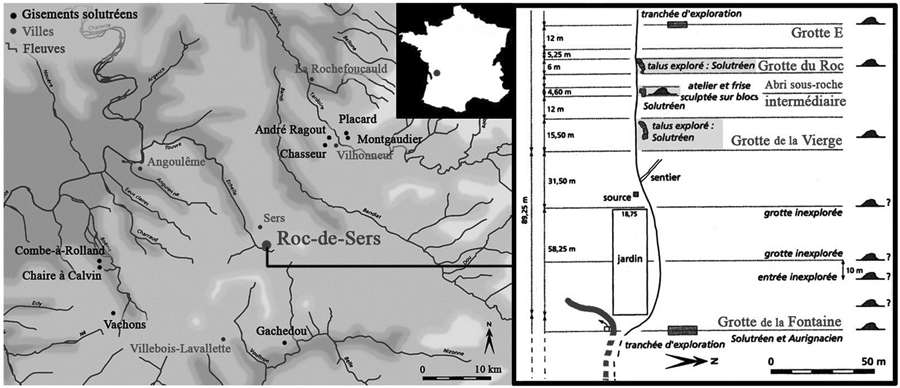
Roc de Sers map.
Material from Roc de Sers has been dated at 19 230 ± 300 BP
Photo and text: Baumann (2008)
Le Roc de Sers
Review of Sophie Tymula 2002. L'art solutréen du Roc de Sers (Charente) (Documents d'archéologie française No. 91) Paris: Maison des sciences de l'Homme, Tymula (2002)
A very different facet of Solutrean life is presented in Sophie Tymula's volume on the Roc de Sers sculpted frieze, one of the relatively few examples of parietal art that can be confidently attributed to this period as it fragmented and fell off the rear wall of the rockshelter into dated archaeological deposits. Sculpture is rare in Upper Palaeolithic parietal art, and, given the relative paucity of Solutrean parietal art in general, Roc de Sers is doubly important, as, in Tymula's view, it serves as a benchmark for defining Solutrean artistic form and technique.
Abundant evidence was recovered from three main activity areas across a large part of the rockshelter and associated small cave; a rich classic Solutrean lithic assemblage bears witness to the production of feuilles de laurier, pointes à cran, burins and grattoirs. Over 52 items of bone and antler including sagaies, lissoirs and two bâtons were recovered, many bearing engraved decoration. Typically Solutrean personal ornamentation comprises pierced animal teeth (generally fox canines), shells and other pendants. Seventeen engraved stone plaquettes reflect the typical bison-horse-cervid theme of Upper Palaeolithic art, and were, like the other symbolic items, recovered under the line of the sculpted wall, reinforcing the notion that this area of the site at least functioned as a 'sanctuary'.
Horse and reindeer dominate the fauna, and all indications are that the occupation took place under cold conditions. With unsatisfying 14 C dates between ~19 000 BP (bulked bone) and ~17 000 BP (AMS) which could make the art contemporary with the Magdalenian art of Lascaux and/or the Badegoulian of Abri Fritsch, the precise chronological position of the site needs clarification. Tymula's inventive and rigorous methodology aims not only to reconstruct the original composition of the parietal frieze, but also the methods of the sculptors, demonstrating that the main artistic objective of sculpture - the interplay between form, light and shadow in the overall work - was fully appreciated by the Solutreans.
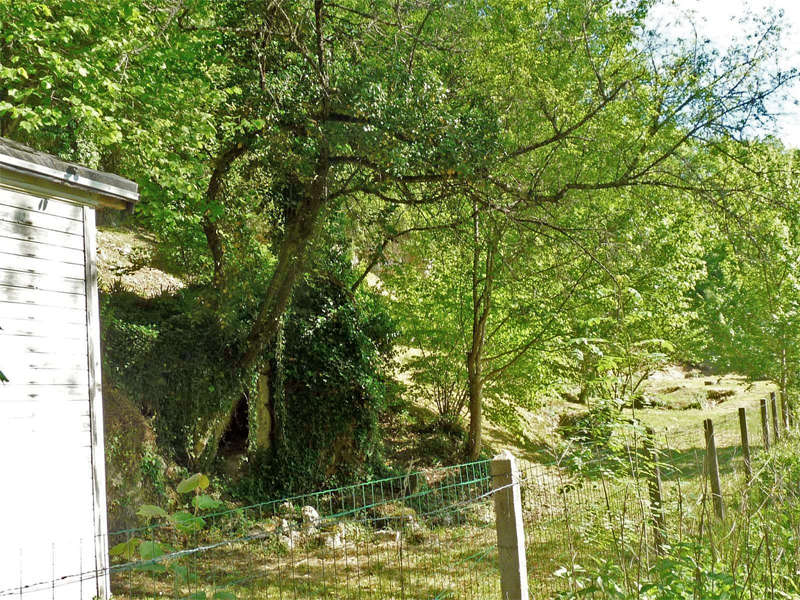
Roc de Sers exterior.
Photo: Jack ma
Permission: GNU Free Documentation License, Version 1.2
Nineteen fragments of the frieze were recovered from the archaeological levels, and a number of these refit, so as to allow a confident reconstruction of their position on the rockshelter wall. It appears that the frieze was ca 10 metres long, and arranged in two tiers and two main 'sides', with enough continuity of style and theme between them to indicate that the frieze formed a compositional whole. Although the sculptures are considerably eroded, enough detail is preserved to reconstruct the manner of production.
The surface of the wall was prepared by pecking, rubbing and scraping, and, in at least some places, charcoal sketches were prepared in advance. The main figures exploited the morphology of the wall and built relief around this, using bas-relief sculpture and engraving to bring out anatomical detail. At least one image was coloured with red ochre. The resulting shading and colour conveys movement, and Tymula estimates that ca 70% of the images are 'animated' in this manner.
Overall, some 51 images present a degree of graphic unity. Some are large (one quarter life size), with smaller ones superimposed upon these. Over half are animals: horse and ibex dominate, followed by bison and reindeer, somewhat similar to the engraved plaquettes, presumably placed on the floor under the frieze and reminiscent of Upper Palaeolithic iconography overall. Tymula recognises two ensembles: one (western) dominated by ibex, the other (eastern) by horse, with a mutual exclusion of the two species.
Although numerically not as important, bison are found in both ensembles, and in this sense bison is 'all pervasive'. Two humanoid figures are found in the horse ensemble. Clear similarities of style and iconography exist between the sculpted frieze and the engraved stone plaquettes, as well as with the Solutrean art of Parpalló and Fourneau du Diable; these confirm a unity of Soltrean symbolic thought. Tymula's reconstruction and analysis of this important frieze should become a standard reference for the understanding of Solutrean art, as well as for the interaction between parietal art and engraved stone plaquettes and other art mobilier.
Text above: http://antiquity.ac.uk/reviews/pettitt.html
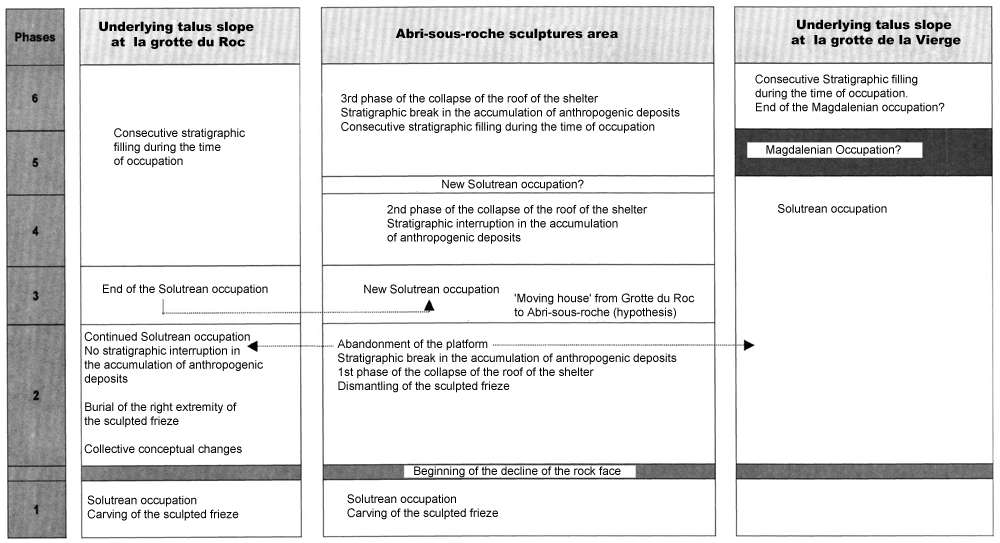
Chronological interpretation of the occupational sequence at Roc de Sers.
Photo: Translated and adapted by Don Hitchcock from Tymula (1999)
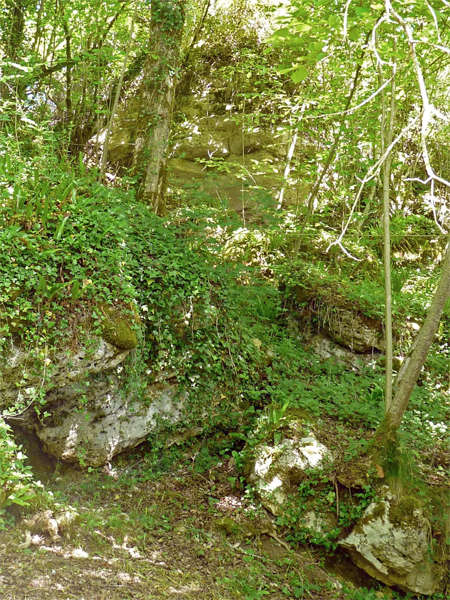
Roc de Sers exterior, the wooded escarpment.
Photo: Jack ma
Permission: GNU Free Documentation License, Version 1.2
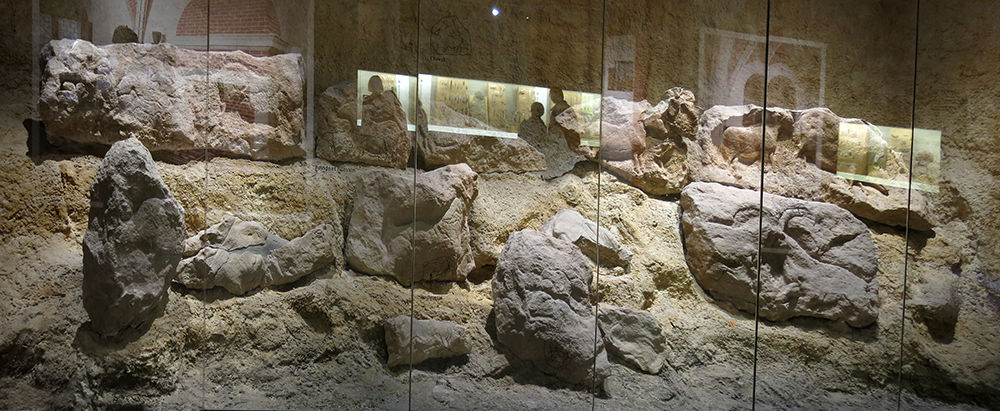
The complete frieze, with the original sandstone blocks.
Photo: Don Hitchcock 2014
Source: Original, Musée d'Archeologie Nationale et Domaine, St-Germain-en-Laye
Roc-de-Sers Inventory
| Fragment | Image | Description | Abbreviation |
|---|---|---|---|
| Fragment ABC | 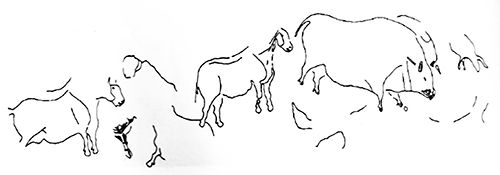 | Bovid Bison/Boar Horse Horse Indeterminate Lines Horse Front left leg of a Bison Incomplete Horse | Bov. 1 Bi.1-Sa.1 Ch.1 Ch.2 Ind.1 à 5 Ch.3 Bi.2 Ch.4 |
| Fragment C' | 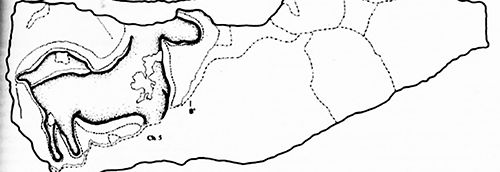 | Horse | Ch.5 |
| Fragment D | 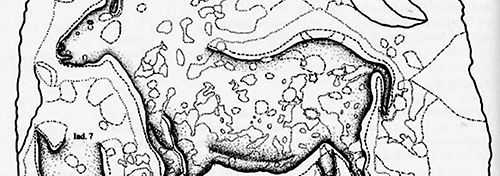 | Horse Vestige of the head of an indeterminate animal Head of an indeterminate animal Red dots | Ch.6 Ind.6 Ind.7 |
| Fragment F | 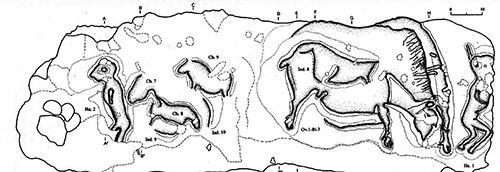 | Musk-Ox/Bison Indeterminate animal Human Figure Human Figure Head of Horse Horse Horse Indeterminate Lines | ov.1-Bi.3 Ind.8 Hu.1 Hu.2 Ch.7 Ch.8 Ch.9 Ind.9 and Ind.10 |
| Fragment H | 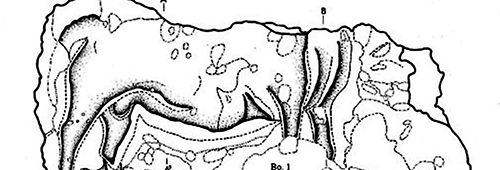 | Incomplete Ibex | Bo.1 |
| Fragment JK | 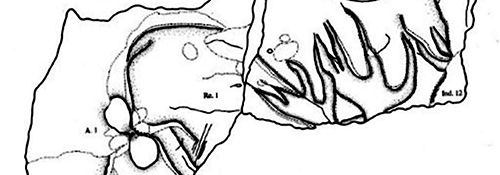 | Incomplete Reindeer Remains of a previous Pierre à Anneau (hole carved in rock used to hold a cord) Indeterminate Lines | Re.1 A.1 Ind.12 |
| Fragment LMNN' | 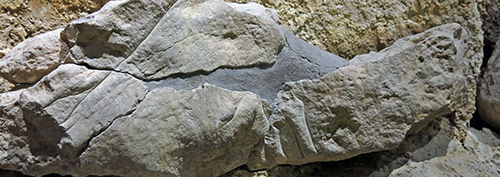 | Incomplete Reindeer | Re.2 |
| Fragment O | 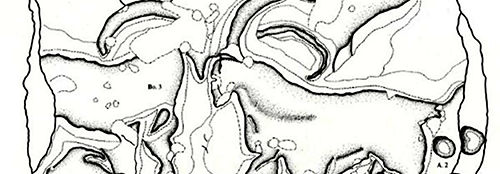 | Ibex confrontation Ibex head Beginnings of a Pierre à Anneau Indeterminate Line | Bo.2 Bo.3 Bo.4 A.2 Ind.13 |
| Fragment P |  | Bison Indeterminate Line | Bi.4 Ind.14 |
| Fragment R | 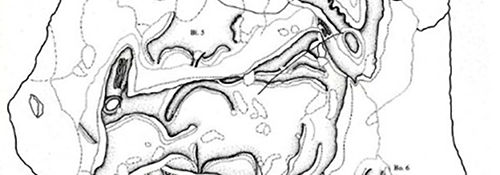 | Ibex Ibex Head Headless Bison Intact Pierre à Anneau | Bo.5 Bo.6 Bi.5 A.3 |
| Fragment S | 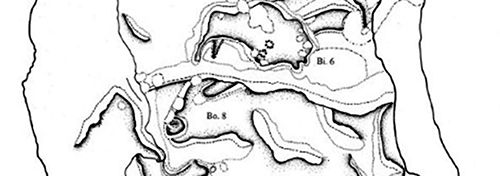 | Headless Ibex Ibex Head Bison | Bo.7 Bo.8 Bi.6 |
Fragment ABC
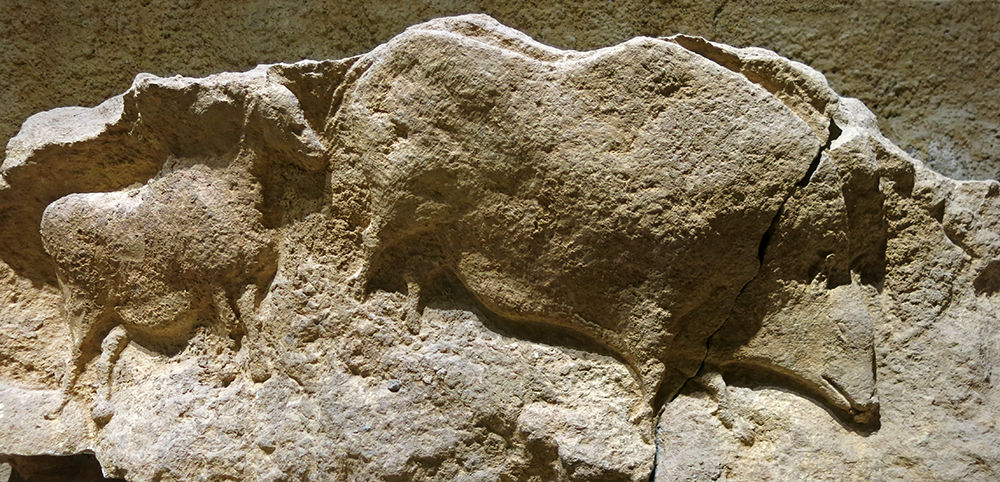
Fragments AB, Assembly 1. A and B together are the largest of the series, and the unit measures 164 cm in length.
Photo: Don Hitchcock 2014
Source: Original, Musée d'Archeologie Nationale et Domaine, St-Germain-en-Laye
Text: Adapted from Tymula (2002)
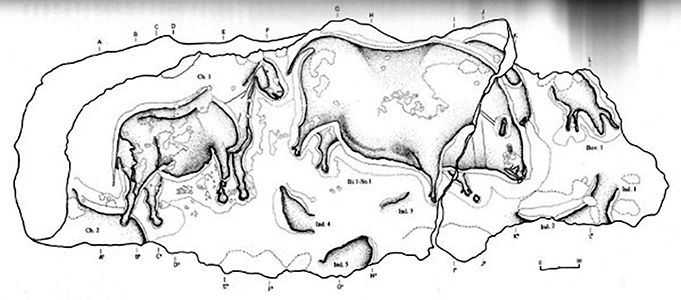
Assembly 1 of Fragments ABC, made up of Fragments A and B, comprising a Bovid, a Bison/Boar, a Horse, and the back of another horse.
Photo and text: Tymula (2002)
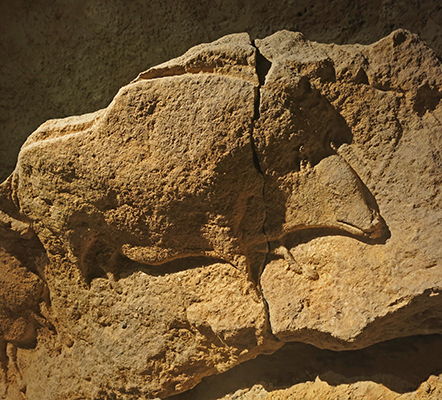
Close up of the boar from Block AB.
Photo: Don Hitchcock 2015
Source: Original, Musée d'Archeologie Nationale et Domaine, St-Germain-en-Laye
Close up of the female gravid horse from Block AB.
Photo: Don Hitchcock 2018
Source: Original, Musée d'Archeologie Nationale et Domaine, St-Germain-en-Laye
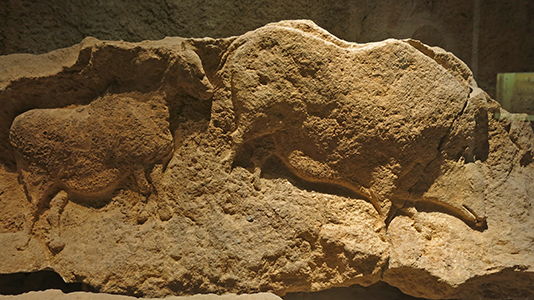
Block AB, Assembly 1.
Photo: Don Hitchcock 2015
Source: Original, Musée d'Archeologie Nationale et Domaine, St-Germain-en-Laye
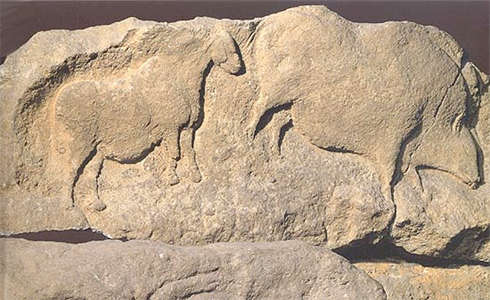
The original carvings of a horse and a boar/bison.
Photo: Airvaux (2001)
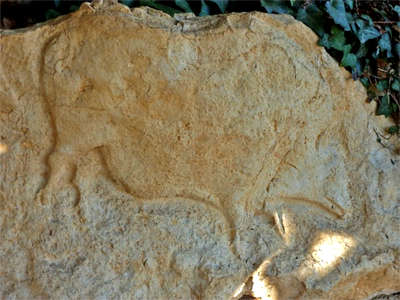
The boar of Fragments AB.
Photo: ©Taupin, http://www.megalithic.co.uk/article.php?sid=31050
Source: Facsimile at the actual site of Roc de Sers.
Block AB seen from the front, and a close up of the boar head.
Photo: Don Hitchcock 2015
Source: Original, Musée d'Archeologie Nationale et Domaine, St-Germain-en-Laye
Fragment C, Assembly 2.
Photo: Don Hitchcock 2014
Source: Original, Musée d'Archeologie Nationale et Domaine, St-Germain-en-Laye
Fragment C, Assembly 2.
Photo: Don Hitchcock 2015, 2018
Source: Original, Musée d'Archeologie Nationale et Domaine, St-Germain-en-Laye
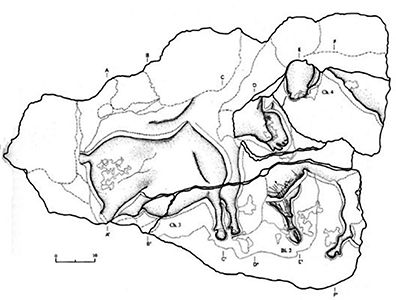
Fragment C is made up of three Horses and a Bison, was well as the front leg of another horse.
Photo and text: Adapted from Tymula (2002)

Fragment C.
Photo: ©Taupin, http://www.megalithic.co.uk/article.php?sid=31050
Source: Facsimile, actual site of Roc de Sers.
Fragment C'
Fragment C'
Photo: Don Hitchcock 2018
Source: Original, Musée d'Archeologie Nationale et Domaine, St-Germain-en-Laye
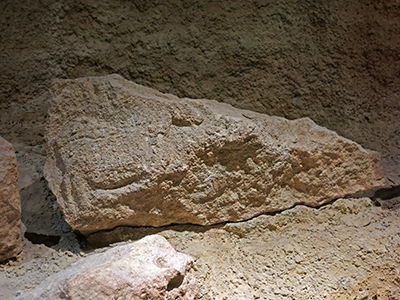
Fragment C'
This fragment appears to have been damaged, as has the horse of Fragment AB, by transportation, as evidenced by the flattened area at the shoulder where the block has rubbed against the wooden case it was transported in. Straw was used as packing material, and was obviously not enough cushioning for such a heavy object, especially if the case was tipped upside down during transportation from the site to Paris.
Photo: Don Hitchcock 2015
Source: Original, Musée d'Archeologie Nationale et Domaine, St-Germain-en-Laye
Fragment C'
This horse Ch.5, facing right, has undergone many changes due to the loss of some of the stone which originally made up the block.
It has a large and unusually high rump.
Photo and text: Tymula (2002)
Fragment D
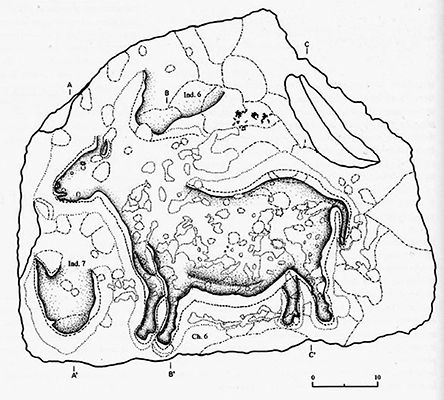
Fragment D
This horse is a massive and powerful figure.
Photo and text: Tymula (2002)

Fragment D.
Photo: Don Hitchcock 2018
Source: Original, Musée d'Archeologie Nationale et Domaine, St-Germain-en-Laye
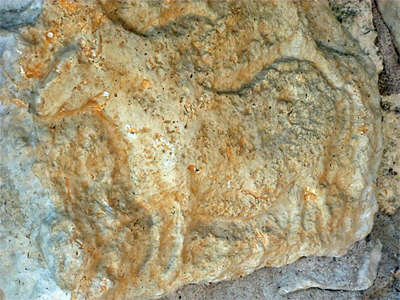
Fragment D facsimile at the actual site of Roc de Sers.
Photo: ©Taupin, http://www.megalithic.co.uk/article.php?sid=31050
Source: Facsmile at the Roc de Sers site.
Fragment F
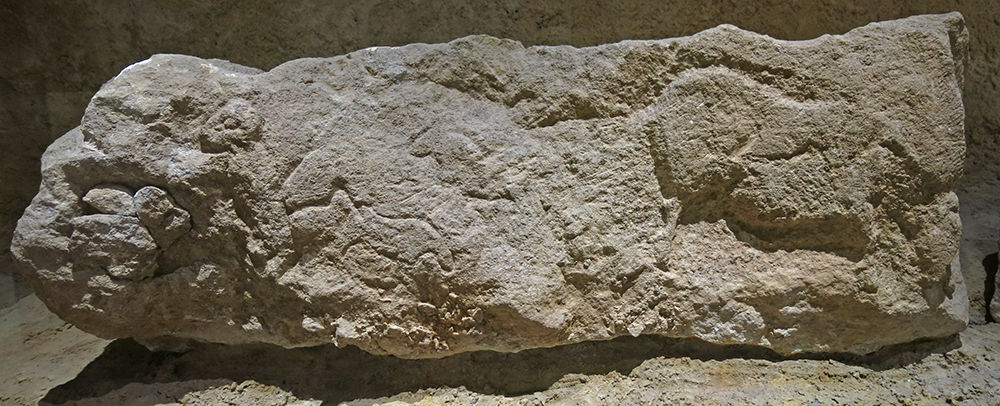
Fragment F.
Photo: Don Hitchcock 2014
Source: Original, Musée d'Archeologie Nationale et Domaine, St-Germain-en-Laye
Fragment F, slightly smaller than the block AB (length = 152 cm) is a composite of seven carved figurative representations.
Group 1 includes a human figure and a musk ox, a bison, and an incomplete animal in left profile.
Group 2 includes a human figure, a horse's head and a horse facing left, and an incomplete horse right profile.
Photo and text: Tymula (2002)
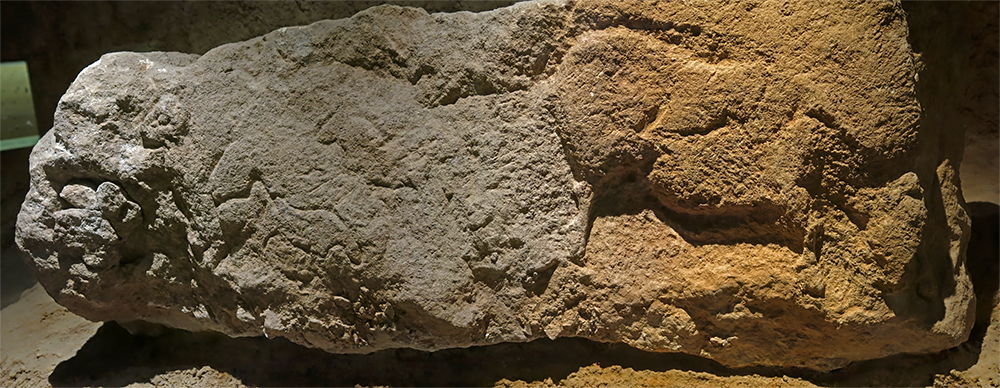
Fragment F.
Photo: Don Hitchcock 2015
Source: Original, Musée d'Archeologie Nationale et Domaine, St-Germain-en-Laye
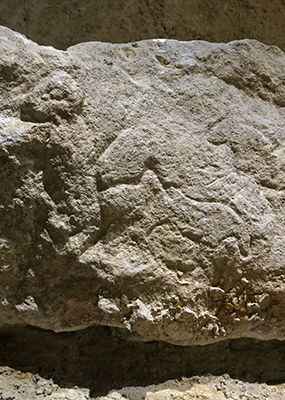
Human figure and three horses.
Photo: Don Hitchcock 2014
Source: Original, Musée d'Archeologie Nationale et Domaine, St-Germain-en-Laye

Human figure and three horses.
Photo: Don Hitchcock 2015
Source: Original, Musée d'Archeologie Nationale et Domaine, St-Germain-en-Laye

Close up of the human figure.
Photo: Don Hitchcock 2018
Source: Original, Musée d'Archeologie Nationale et Domaine, St-Germain-en-Laye

Close up of two of the horses.
Photo: Don Hitchcock 2014
Source: Original, Musée d'Archeologie Nationale et Domaine, St-Germain-en-Laye
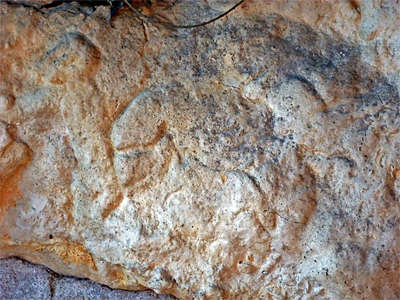
Fragment F, a facsimile at the Roc de Sers site itself.
Photo: ©Taupin, http://www.megalithic.co.uk/article.php?sid=31050
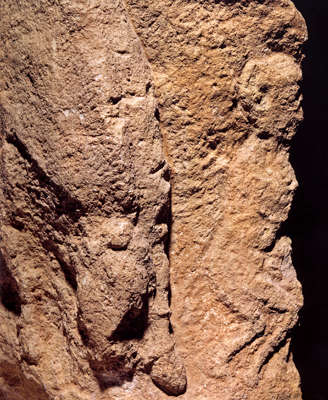
The Musk Ox scene.
Photo: Cook (2013)
Man pursued by Musk Ox.
Photo: Don Hitchcock 2015
Source: Original, Musée d'Archeologie Nationale et Domaine, St-Germain-en-Laye
Man pursued by Musk Ox.
Photo: Don Hitchcock 2015
Source: Original, Musée d'Archeologie Nationale et Domaine, St-Germain-en-Laye
Man pursued by Musk Ox.
Photo: Don Hitchcock 2018
Source: Original, Musée d'Archeologie Nationale et Domaine, St-Germain-en-Laye

Close up of the man pursued by a Musk Ox.
Photo: Don Hitchcock 2015
Source: Original, Musée d'Archeologie Nationale et Domaine, St-Germain-en-Laye

Roc de Sers bas relief. This block shows a musk ox pursuing a man, shown here as a facsimile at the original site of Roc de Sers.
Photo: ©Taupin, http://www.megalithic.co.uk/article.php?sid=31050
Drawing of the objects on block 114-F of Roc-de-Sers:
a) First human
b) Musk Ox
c) Second human
d) Head of a horse
e), f), g) bovid
Photo and text: Duhard et al. (1996)
Drawing G. Tossello, © Duhard
Fragment G
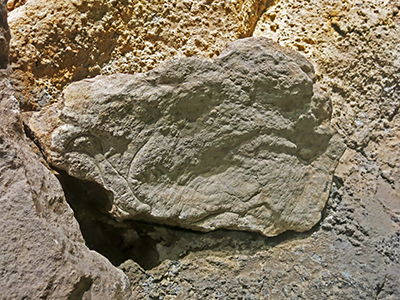
Fragment G.
Photo: Don Hitchcock 2015
Source: Original, Musée d'Archeologie Nationale et Domaine, St-Germain-en-Laye
This fragment includes an incomplete bird and rump and thigh of an unknown animal.
The bird Oi.1 is engraved on the left end of the fragment; it is incomplete due to fracturing of the block.
Photo and text: Tymula (2002)
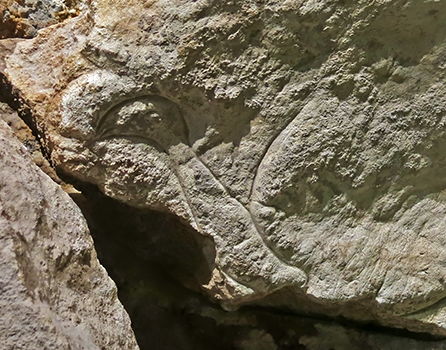
Close up of the bird on Fragment G.
Photo: Don Hitchcock 2015
Source: Original, Musée d'Archeologie Nationale et Domaine, St-Germain-en-Laye
Fragment H
Fragment H.
Photo: Don Hitchcock 2018
Source: Original, Musée d'Archeologie Nationale et Domaine, St-Germain-en-Laye

Fragment H
This block is very incomplete. However, one can distinguish the lower half of a quadruped, which was identified as a bison by Epoudry, whilst Tymula believes it to be an ibex.
Photo and text: Adapted from Tymula (2002)
Fragment H, another view.
Photo: Don Hitchcock 2015
Source: Original, Musée d'Archeologie Nationale et Domaine, St-Germain-en-Laye
Fragment JK
Fragment JK.
Photo: Don Hitchcock 2018
Source: Original, Musée d'Archeologie Nationale et Domaine, St-Germain-en-Laye
Fragment JK
This fragment has the characteristic antlers and hindquarters of a Reindeer, Re.1.
The antlers are well carved, and show that the representation is of a male reindeer at the completion of growth of the antlers in summer-autumn.
On this fragment there is also evidence of the previous existence of a pierre à anneau, evidenced now by two cones which meet at an oblique angle. The ring of the pierre à anneau has been broken off, either through use at the time of its creation or when the block fell from the wall. It was a very narrow ring, of only ~ 5 mm in diameter.
Photo and text: Adapted from Tymula (2002)
Fragment LMNN'
Incomplete reindeer, Re.2
Photo: Don Hitchcock 2018
Source: Original, Musée d'Archeologie Nationale et Domaine, St-Germain-en-Laye
Fragment O
Two ibex striving for dominance during the rut.
Photo: Don Hitchcock 2018
Source: Original, Musée d'Archeologie Nationale et Domaine, St-Germain-en-Laye
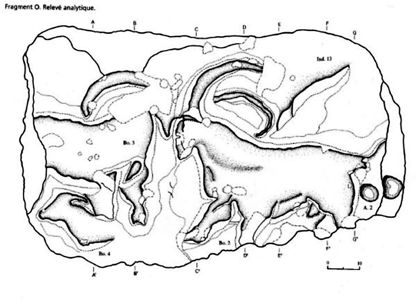
Photo: Adapted from Tymula (2002)
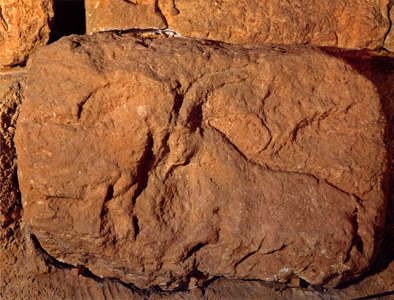
Photo: Cook (2013)
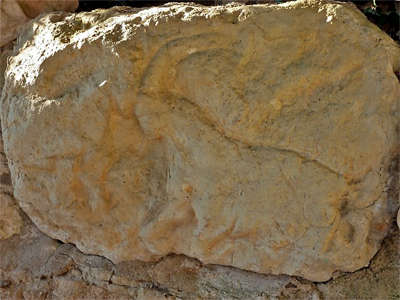
Facsimile of fragment O at the actual site of Roc de Sers.
Photo: ©Taupin, http://www.megalithic.co.uk/article.php?sid=31050
Fragment P
Photo: Don Hitchcock 2015, 2018
Source: Original, Musée d'Archeologie Nationale et Domaine, St-Germain-en-Laye
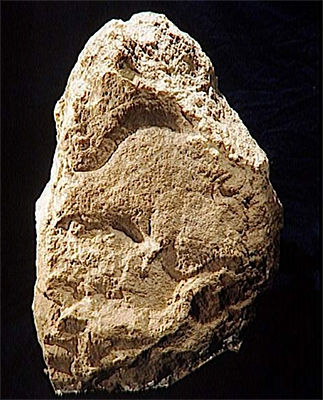
Bison, fragment P
Photo: Tymula (2002)
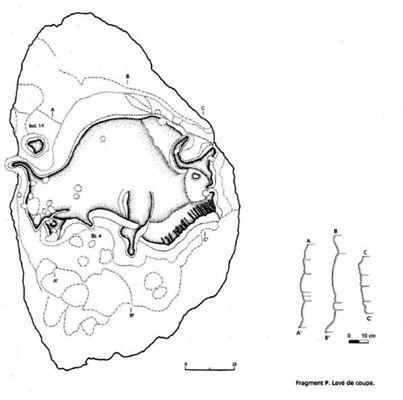
Fragment P
The sculpture in the centre of this fragment represents a bison in right profile. The animal does not graze, it does not move: it is stationary, and looks at the observer.
Photo and text: Adapted from Tymula (2002)
Fragment R
Ibex of Fragment R, from a different angle.
Note the presence of an intact Pierre à Anneau at the top right hand of the block.
Photo: Don Hitchcock 2015
Source: Original, Musée d'Archeologie Nationale et Domaine, St-Germain-en-Laye
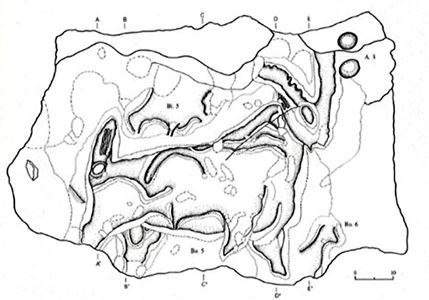
Fragment R
Ibex Bo.5 is incomplete because of breakages of the block, but depicts a male ibex with a small pointed beard.
Photo and text: Adapted from Tymula (2002)
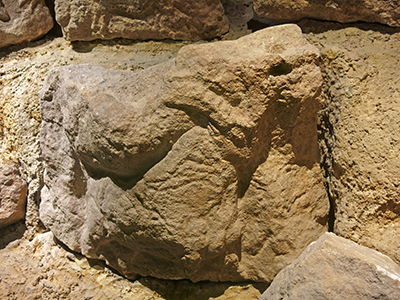
This view shows the head of the ibex clearly.
Photo: Don Hitchcock 2015
Source: Original, Musée d'Archeologie Nationale et Domaine, St-Germain-en-Laye

This is a curious design at the rear of the Ibex, like a grossly enlarged eye, and the deformed head and body of another ibex, from the left profile.
Photo: Don Hitchcock 2015
Source: Original, Musée d'Archeologie Nationale et Domaine, St-Germain-en-Laye
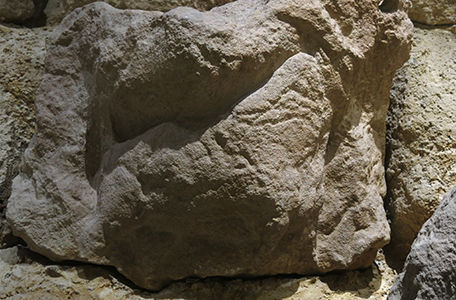
The ibex has a very muscular appearance, and has been depicted with verve and vitality.
Photo: Don Hitchcock 2014
Source: Original, Musée d'Archeologie Nationale et Domaine, St-Germain-en-Laye
Fragment R.
Photo: Don Hitchcock 2018
Source: Original, Musée d'Archeologie Nationale et Domaine, St-Germain-en-Laye
Fragment S
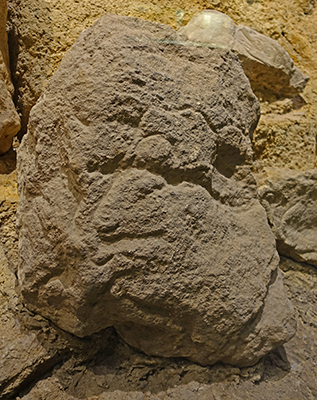
Fragment S.
This fragment was still attached to the wall when it was discovered in 1951.
Photo: Don Hitchcock 2018
Source: Original, Musée d'Archeologie Nationale et Domaine, St-Germain-en-Laye
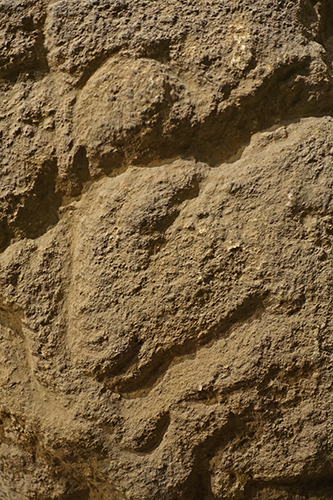
Fragment S, close up of the head of an ibex.
Photo: Don Hitchcock 2018
Source: Original, Musée d'Archeologie Nationale et Domaine, St-Germain-en-Laye
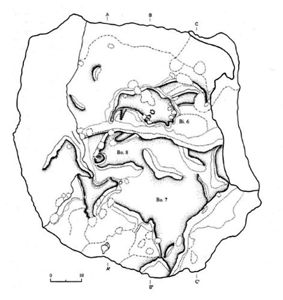
Fragment S.
Legend: Bi. - Bison, Bo. - Ibex.
Photo and text: Adapted from Tymula (2002)
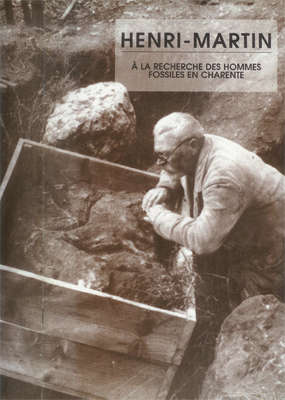
Dr Henri-Martin examining the Ibex carved at Roc-de-Sers, packed ready for removal to the Musée d'Archéologie Nationale at Saint-Germain-en-Laye.
Photo: Debénath et Tournepiche (1993)
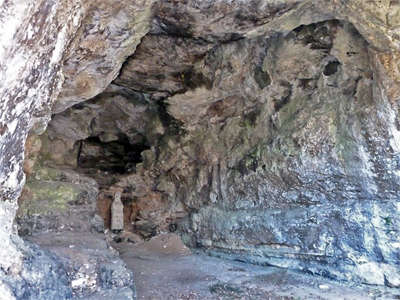
Roc de Sers Site in Poitou-Charente
Photo: ©Taupin, http://www.megalithic.co.uk/article.php?sid=31050
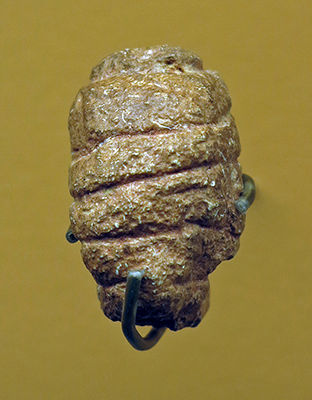
Tête humaine striée (?) sculptée en calcaire
Striated human head (?) sculpted in limestone.
Photo: Don Hitchcock 2014
Source: Facsimile, Musée d'Archeologie Nationale et Domaine, St-Germain-en-Laye
Slab of sandstone engraved with the figure of a mammoth.
Photo: Don Hitchcock 2015
Source: Original, Musée d'Archeologie Nationale et Domaine, St-Germain-en-Laye
Black and white photo: Unknown, rephotographed by Don Hitchcock 2015
Source: Display, Musée d'Archeologie Nationale et Domaine, St-Germain-en-Laye
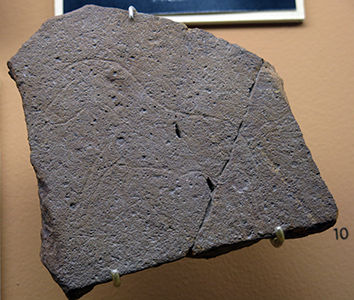
Slab of sandstone engraved with the figure of a horse.
Photo: Don Hitchcock 2014
Source: Original, Musée d'Archeologie Nationale et Domaine, St-Germain-en-Laye
Slab of sandstone engraved with the figure of a horse.
Photo: Don Hitchcock 2018
Source: Original, Musée d'Archeologie Nationale et Domaine, St-Germain-en-Laye

Drawing of an ornamented Roc de Sers 'ciseau'.
(Possibly a lissoir for preparation of hides - Don )
Photo: Dujardin et al. (2005), Tymula (1998, 1999)
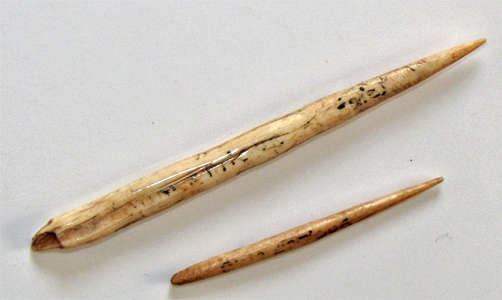
Two points from Roc de Sers. They come from an upper Solutrean layer, dated to ca 19 000 BP.
Photo and text: http://www.aggsbach.de/2011/03/bone-implements-from-roc-de-sers/
Les fouilles du sanctuaire solutréen du Roc-de-Sers (Charente) en 1951
Translation Don Hitchcock
Interrupted since 1929, excavations were resumed at the Roc de Sers from 4th to 15th June 1951, after the chance discovery of a fragment of the great sculpted frieze on the wall of the Solutrean sanctuary, explored from 1927 to 1929 by Dr. Henri-Martin.
The site is found as a semicircular shelf under a cliff. Some distance away, a Palaeolithic (now reliably dated to the Bronze Age - Don ) burial was discovered under huge blocks of stone which seemed to mark the borders of the area. Although protected by a fence, the burial continued to attract the attention of intrusive clandestine diggers, who, with the aid of a stick pushed through the fence tried to get a souvenir of their visit, so much so that one day there appeared in the left corner of the grave a new block carved with the image of an ibex, as reported by Monsieur P. David. Further research was necessary.
The place of worship is then presented under a cliff adjoining the southern platform and pretend to draw a wide semicircle appearance. At some distance, it was discovered Paleolithic burial "sub-blocks" behind huge blocks which seemed to mark the boundaries of the sanctuary. Although protected by a fence, burial had ceased to attract the attention of intrusive clandestine researchers, using a stick passed through the fence, trying to get a souvenir of their visit to Roc , so much so that one day appeared in the left corner of the grave, a new block carved with the image of an ibex, reported by MP David. Further research was needed.
With the help of Mlle Germaine Henri-Martin, and after a long process of clearing and scraping the field, it was found that the slab overlying the tomb was not in place and that the other two blocks near it rested on an older archaeological layer. After removing 50 tons of boulders, it became clear that these slabs do not represent anything other than rocks fallen from the roof of the abri, once protecting the cave entrances of the Grotte de la Vierge and Grotte du Roc.
It was possible to work out the times of these rockfalls: the farthest block from the burial had already fallen before the establishment of the burial, the middle block lay on a gravel slope at the start of a sand deposit, the third had fallen when the site of the Roc had been already abandoned by its Solutrean occupants, after the formation of a layer of rubble, sealing the site of the grave, which had not been dug in an abri but in an important Solutrean home.
These findings not only change the general character of the burial, they now recognise the stones and the sand deposits in which the skeletons were found, as voluntary contributions for the burial.
Slow infiltration of topsoil completed the filling, carrying objects of all kinds and from very different eras, parts of shoes, broken glass and pottery, driven by a hairy root into the depths of the archaeological layer. These findings contradict the hypothesis of the existence of ceramics at the Roc. The fragment of a large vase collected near one of the skulls is thus a recent addition.
With regard to the sanctuary, far from ending in a semicircle at one of its ends, which was defined by huge boulders, it probably goes beyond this limit in the form of a long flat shelf, more or less straight, and the triple burial represents no more than one episode of the last Solutrean occupation of the site, at a time when it was not often used as a sanctuary.
The new Ibex block was covered by a large Solutrean hearth, making the earth blackish, with ash, debris of animals and industry, witnesses to a very long time that humans used the platform. The crushing of artefacts and the scarcity of flint found in the vertical position in the layer suggest a long trampling. This level was already formed when the collapse occurred, as evidenced by the penetration of boulders with embedded shaped corners.
The archaeological layer has a remarkable homogeneity. However at the halfway point its colour changes at a depth of 12 centimetres and is significantly less rich. There is a displacement of the hearths towards the rocky wall, decreasing in occurrence as we move away from it. It seems that we can find on this site the same industrial sequences as those accorded during excavations of Dr. Henri-Martin in the S layer: the same faunal units where the remains of young reindeer dominate, with horse and bovids significantly less frequent, and some Canidae.
The bone industry is very poor and ill-defined, and lithic material, where the Solutrean knapping technique dominates, confirms the character of the layer, with laurel leaf and willow points, shouldered points, scrapers, burins and blades. The material used is mostly flint, but rock crystal, quartz and quartzite were sometimes used. The presence of pockets of small chips indicates the presence of workshops in various places in this layer.
During the course of the work, the Ibex block, still up on the rocky bank on which it was carved, was entirely finished, as well as a second block, also in place, down to the left and covered with composite figures. Although incomplete, a large part of the stone has disappeared, the first of these new blocks is decorated with the image of a male ibex, in right profile, shown walking. In front of the animal, a projection of stone indicates the presence of a second figure, of which the traces left are rather confused. Above the Ibex, attributable to the spine and neck, a strong projection denotes a rounded and bulging motif correspondingly during the execution of the Ibex. At the end of the stone and the horn, broken at the top, had been placed a small ring.
The second block is covered with complementing and overlapping images: the head of a young caprid, then the head of a Bison, the muzzle down, the left foreleg stretched and brought under the muzzle. The incomplete body uses the dorsal line of another animal, perhaps an ibex, whose legs and belly can still be seen.
The discovery, in the same location they occupied on the walls of the sanctuary, of these new fragments has not only the result of singularly expanding its boundaries and greatly changing the character of the general arrangement. It also solves the uncertainties that one could have regarding the membership of some of these sculptures at a place of worship, all performed directly on the rocky banks by Solutrean artists. It is then possible to doubt a wilful destruction of these sculptures. It seems more logical to explain the splitting of the rock from the action of natural phenomena.
The unity of technique and style of all these figures is indisputable, as well as the procedures used in the reutilisation of the surfaces. The two new blocks are examples of the characteristics already identified elsewhere on the bird fragment and the Bovid. In the bestiary, Horses and Bovids predominate, followed by the Reindeer and Ibex, but even if all these images belong to the Solutrean, they are not contemporary, and the choice made in the representation of the animals corresponds to changes in the religious conceptions of the hunters who, at various times, frequented the place of worship.
It is possible to attempt a reconstruction of the frieze using these blocks, found either on the platform of the sanctuary or below it, into two groups, separated by a seven metre wide section which does not contain any sculptures. It thus seems possible to admit the existence of a frieze built along two or three levels, first with the images of Horses, Bovidae, of Reindeer and the Bird, and the block showing the Musk-Ox charging a man, then after a break which could be explained by the narrowing of the platform, the figures of ibex and the block of composite representations. This is only an attempt at a possible reconstruction, I freely admit that it is conjectural, and further excavations may confirm or deny these hypotheses.
Major changes were made to the view of the bank that was present in the Solutrean at the Sanctuary of the Roc. Like Angles-sur-Anglin (Vienne, France), the place of worship had been established under a gigantic abri, protected by projecting vaults and the caves of the Virgin and of the Rock which overlook them. They collapsed, some during the Solutrean. It is not impossible to attribute the collapses to the action of ice, similar to those at Angles-sur-Anglin which, after the Magdalenian III, produced powerful rock falls resulting in sculptures falling from the roof and walls. The similarities between the two sanctuaries do not stop at their similar layouts. The bestiary represented is no different, and some details of execution offer striking parallels: for example, the way that the ears of animals are rendered. At both sites engraved plaques were collected, and as at Angles-sur-Anglin, so at the Roc, some blocks had a small annulus made in the stone.
However, if our excavations have brought new and accurate insights into the order of the sanctuary, they do not allow us to answer questions posed concerning the history of the occupation of the site. It is clear that the place of worship was abandoned by the time that human groups left traces of their stay in the Grand Hearth S. But it is difficult to relate these later occupations with the times during which the area was an active sanctuary when the sculptures were made.
Small fireplaces were discovered beneath the fallen blocks, above and near the burial, which reflect short occupations by hunters during the early Magdalenian.
References
- Airvaux, J., 2001: L'art Prehistorique Du Poitou-Charentes: Sculptures Et Gravures Des Temps Glaciaires, Maison des roches, 2001
- Baumann, M., 2008: Exploitation des matières osseuses par les groupes solutréens du Roc de Sers (Charente, France). Master's Thesis II, L'Université Paris Ouest Nanterre
- Cook, J., 2013: Ice Age art: arrival of the modern mind, The British Museum, 18 Feb 2013, ISBN-10: 0714123331, ISBN-13: 978-0714123332
- Debénath A., Tournepiche J., 1993: Henri-Martin à la recherche des hommes fossiles en Charente, catalogue et exposition réalisés par André Debénath et Jean-François Tournepiche, 1 vol. (n. p.) : ill. en noir ; 29 cm, Exposition. Angoulême. 1993
- Duhard, J., Tosello, G., 1996: Relecture du bloc aux humains de l'abri de la Vallée du Roc (commune de Sers, Charente), Bulletin de la Société préhistorique française, 1996, tome 93, N. 4. pp. 528-533.
- Dujardin, V., Tymula S., 2005: Relecture chronologique de sites paléolithiques et épipaléolithiques anciennement fouillés en Poitou-Charentes, Bulletin de la Société préhistorique française, 2005, tome 102, N. 4. pp. 771-788.
- Lantier, R., 1952: Les fouilles du sanctuaire solutréen du Roc-de-Sers (Charente) en 1951, Comptes rendus des séances de l'Académie des Inscriptions et Belles-Lettres, 96e année, N. 2, 1952. pp. 303-307.
- Tymula, S., 2002: L'art solutréen du Roc de Sers (Charente), Documents d'archéologie française No. 91, Maison des Sciences de l'Homme, ISBN-10: 2735108082 ISBN-13: 978-2735108084, a summary is available at http://solutreen.over-blog.com/article-l-animal-valeur-symbolique-l-art-parietal-solutreen-du-roc-de-sers-71875818.html
- Tymula, S., 1998: La frise sculptée solutréenne du Roc de Sers (Charente): nouvelles données d'art pariétal, L'Anthropologie, t. 102, No 2, p. 143-165.
- Tymula, S., 1999: L'art du Roc de Sers (Charente) dans son contexte solutréenm , thèse de doctorat, université de Paris-I (Panthéon-Sorbonne), 2 vol.
- Vialou D., 1998: Prehistoric Art and Civilization (Abrams Discoveries), Harry N. Abrams; (October 1, 1998)
Back to Don's Maps
 Back to Archaeological Sites
Back to Archaeological Sites
